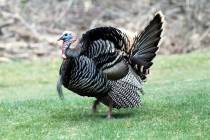Stripers keep anglers alert through ‘periodic payouts’
The striped bass in Lake Mead have taken a page from the casino industry's playbook. They have adopted the use of "periodic payouts" as a means of keeping the attention of anglers hoping to put a few of the fish on their stringers. Sometimes these periodic payouts come in the form of a striped bass, and sometimes the payout comes in the form of a striper boil.
A striper boil occurs when hungry stripers corral a school of small baitfish -- such as threadfin shad at Lake Mead -- and begin eating them. In an effort to escape the onslaught, shad head for the water's surface and attempt to leap away from the stripers. The result is a significant disturbance on the water's surface, where the shad can be seen doing aerial acrobatics in a futile attempt to escape from the striped bass dinner menu. The clearly audible sound made when this happens is like that associated with the rushing wind.
Such was the case on Veterans Day near the new fishing pier in Boulder Harbor, former home of Lake Mead Marina. One guy on the end of the pier seemed to catch a striper about every 20 minutes. Other anglers sharing the pier weren't as successful.
But just when it seemed the others were getting discouraged, the striped bass would chase the shad and cause them to boil on the surface. Anglers on the pier would quickly bait their hooks. One fisherman started to leave several times, and each time the call of the boil hailed him back. That's the art of periodic payouts.
Action for striped bass was fair all morning, though a couple of smallmouth bass were caught. Some of the fishermen used cut anchovies, but most success came on live shad that were netted nearby. Shore anglers didn't seem to fare as well.
On my way back to Vegas, I dropped by Veterans Memorial Park in Boulder City and lost a few flies to the thieving trees. Stocked rainbows were hitting small spinners, PowerBait, marshmallows and PowerWorms.
WATERFOWL OPPORTUNITIES
Just a few ducks are working Peterson Reservoir on the Ash Meadows National Wildlife Refuge north of Pahrump. Brock Perry, an ardent waterfowl hunter who teaches duck hunting seminars, said a significant drop in the water level at lower Crystal Marsh has pushed birds to the upper marsh. Hunters can hunt only the south end of the upper marsh, he said.
Hunters making the trip to the Kirch Wildlife Management Area, also known as Sunnyside, should find fair numbers of birds, including teal, gadwall, pintail and geese. Hunters probably will see skim ice conditions in the early morning, but it should melt off. The mosquitoes might be thawed out by the late afternoon hunt, so bring repellent containing DEET.
"At Nesbitt Lake on the Key Pittman WMA, hunters will find a good number of birds that are easy to decoy and offer some of the better pass shooting opportunities," Perry said. "There are some canvasbacks working the valley, so hunters need to be careful."
The season on canvasbacks is closed this year. Hunters in the Pahranagat Valley are seeing teal, pintails, widgeon, mallards and a few Canada and snow geese. On the Pahranagat National Wildlife Refuge, hunters are taking teal, widgeon and mallards. Jump shooting on the middle marsh has been productive in the early mornings. Further south at the Overton WMA, hunting has been slow. Hunters are still seeing a few resident geese.
Perry recommends using Mojo decoys in your decoy spread and calling with a pintail whistle. "Birds that are shy of mallard calls will respond to the pintail call," he said. Perry will be teaching a duck-calling seminar at 5 p.m. Sunday at Sportsman's Warehouse in Henderson.
Freelance writer Doug Nielsen is a conservation educator for the Nevada Department of Wildlife. His column is not affiliated with or endorsed by the department. Any opinions he states in his column are his own. He can be reached at doug@takinitoutside.com.

















